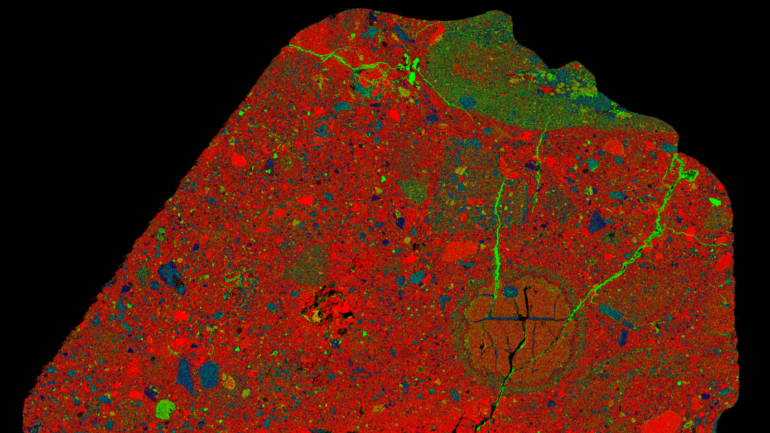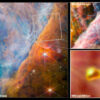The coming decade is expected to bring a veritable bonanza for the science of planets: space missions are scheduled to bring back samples of rock from the moon, Mars, the Martian moon of Phobos, and a primitive asteroid. And scientists say there is a new technique for determining the age of rocks, meteorites, and even artifacts, that could help open up a new era of discovery.
A group with the University of Chicago and the Field Museum of Natural History tested an instrument made by Thermo Fisher Scientific on a piece of a Martian meteorite nicknamed “Black Beauty” and were able to quickly and precisely date it by probing it with a tiny laser beam—a significant improvement over past techniques, which involved far more work and destroyed parts of the sample. Their research is published in the Journal of Analytical Atomic Spectrometry.
“We are very excited by this demonstration study, as we think that we will be able to employ the same approach to date rocks that will be returned by multiple space missions in the future,” said Nicolas Dauphas, the Louis Block Professor of Geophysical Sciences at the University of Chicago and first author on a study laying out the results. “The next decade is going to be mind-blowing in terms of planetary exploration.”
Rock of ages
Scientists have been using isotopes to estimate the ages of specimens for more than a century. This method takes advantage of the fact that certain types of elements are unstable and will slowly turn into other types at a slow, predictable rate. In this case, scientists tap the fact that rubidium-87 will change into strontium-87—so the older the rock is, the more strontium-87 it will have.
Rubidium dating can be used to determine the ages of rocks and objects that are billions of years old; it is widely used to understand how the moon, Earth, and solar system formed, to understand the magma plumbing system beneath volcanoes, and to trace human migration and trades in archaeology.
Previously, however, the way to make this measurement would take weeks—and it would destroy part of the sample.
To perform those tests with the conventional method, “you take your piece of rock, crush it with a hammer, dissolve the minerals with chemicals and use a special ultra-clean laboratory to process them, and then take it to a mass spectrometer to measure the isotopes,” explained study co-author Maria Valdes, a postdoctoral researcher in the Robert A. Pritzker Center for Meteoritics and Polar Studies at the Field Museum of Natural History.
But Thermo Fisher Scientific developed a new machine that promised to significantly cut the time, toxicity, and amount of sample destroyed in the process. It uses a laser to vaporize a tiny portion of the sample—the hole created is the size of a single human hair—and then analyzes the rubidium and strontium atoms with a mass spectrometer that uses new technological advances to cleanly measure strontium isotopes.
Dauphas, Valdes, and several other collaborators wanted to test out the new technique—and they had a perfect candidate: a piece of meteorite that landed on Earth from Mars.
This particular meteorite is nicknamed Black Beauty for its gorgeous dark color. It is flecked with lighter fragments that represent even older rocks imbedded in the rock.
However, these fragments were rolled up into another rock at some point much later during Mars’ history. It’s a bit like when you’re baking cookies, explained Valdes; the chocolate chips and nuts were made at different times and places, but all the components come together when you bake the cookie.
Scientists want to know the ages of all of these steps along the way, because the composition of each set tells them about what the conditions were like on Mars at the time, including the makeup of the atmosphere and the volcanic activity on the surface. They can use this information to piece together a timeline of Mars.
However, thus far, parts of the story were disputed; different studies had returned different answers for the age when all the components of Black Beauty came together and formed one rock—so the scientists thought the meteorite would be a perfect candidate to test the capabilities of the new technique. They took a sample of Black Beauty to Germany to try it out.
In a matter of hours rather than weeks, the instrument returned its answer: 2.2 billion years old. The team thinks this represents the time when it coalesced into its final form.
What’s more, to perform the test, the scientists were able to place the entire meteorite chunk in the machine and then precisely select a tiny site to test the age. “This was a particularly good tool to solve this controversy,” said Dauphas. “When you chip out a piece of rock to test the old way, it’s possible you are getting other fragments mixed in, which may affect your results. We do not have that problem with the new machine.”
The technique could be extremely useful in many fields, but Dauphas and Valdes are particularly interested in it for understanding everything from the history of water on Mars’ surface to how the solar system itself formed.
In the next decade, scientists are expecting a bonanza of new samples from places other than Earth. The U.S. and China are planning new missions to the moon; a missions to intercept an asteroid called Bennu will land in 2023 with payloads of dirt scooped from its surface; another mission will bring back samples from Mars’ moon Phobos in 2027; and by the early 2030s, NASA hopes to bring back samples that the Perseverance rover is now collecting on Mars.
With all of these samples, scientists expect to learn much more about the planets and asteroids around us.
“This is a huge advance,” Dauphas said. “There are many precious meteorites and artifacts that you don’t want to destroy. This allows you to tremendously minimize the impact you have during your analysis.”
More information:
Nicolas Dauphas et al, In situ 87Rb–87Sr analyses of terrestrial and extraterrestrial samples by LA-MC-ICP-MS/MS with double Wien filter and collision cell technologies, Journal of Analytical Atomic Spectrometry (2022). DOI: 10.1039/D2JA00135G
Provided by
University of Chicago
Citation:
New technique to determine age will open new era of planetary science, researchers say (2022, October 26)



